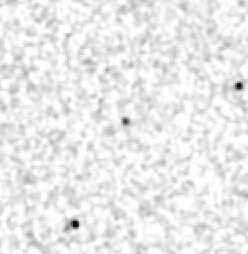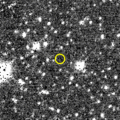Lysithea (moon) facts for kids
 |
|
| Discovery | |
|---|---|
| Discovered by | S. B. Nicholson |
| Discovery date | July 6, 1938 |
| Designations | |
| Adjectives | Lysithean |
| Orbital characteristics | |
|
Mean orbit radius
|
11,720,000 km |
| Eccentricity | 0.11 |
| 259.20 d (0.69 a) | |
|
Average orbital speed
|
3.29 km/s |
| Inclination | 28.30° (to the ecliptic) 25.77° (to Jupiter's equator) |
| Satellite of | Jupiter |
| Physical characteristics | |
|
Mean radius
|
18 km |
| ~4100 km2 | |
| Volume | ~24,400 km3 |
| Mass | 6.3×1016 kg |
|
Mean density
|
2.6 g/cm3 (assumed) |
| ~0.013 m/s2 (0.001 g) | |
| ~0.022 km/s | |
| Albedo | 0.04 (assumed) |
| Temperature | ~124 K |
Lysithea (ly-SITH-ee-ə) is one of the many moons that orbit the giant planet Jupiter. It is not perfectly round like Earth's Moon; instead, it has an irregular shape. Lysithea orbits Jupiter in the same direction that Jupiter spins.
This moon was discovered by an astronomer named Seth Barnes Nicholson in 1938. He found it while working at the Mount Wilson Observatory. Lysithea is named after a character from ancient Greek mythology.
Naming Lysithea
When Lysithea was first found, it didn't have a special name. It was simply called Jupiter X. The "X" means it was the tenth moon discovered around Jupiter.
It wasn't until 1975 that this moon officially received the name Lysithea. For a short time between 1955 and 1975, some people also called it "Demeter".
Where Lysithea Orbits
Lysithea is part of a group of moons known as the Himalia group. This group includes five moons that travel around Jupiter. They orbit quite far from Jupiter, between 11 million and 13 million kilometers away.
Lysithea's orbit is tilted at about 28.3 degrees compared to Jupiter's equator. The path it takes around Jupiter is always changing a little bit. This is because the gravity from the Sun and other planets pulls on it.
Facts About Lysithea
Lysithea is a relatively small moon. Its average radius is about 18 kilometers. This means it's roughly 36 kilometers wide.
Scientists estimate its mass to be around 63 quadrillion kilograms. It's thought to have a density of about 2.6 grams per cubic centimeter. This is similar to the density of rocks on Earth.
The surface of Lysithea is very cold. Its average temperature is around -149 degrees Celsius (124 Kelvin). This is because it's so far from the Sun.
Images for kids
See also
 In Spanish: Lisitea (satélite) para niños
In Spanish: Lisitea (satélite) para niños


